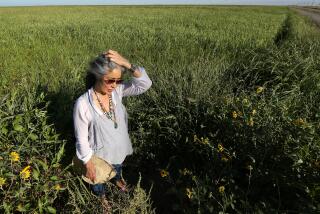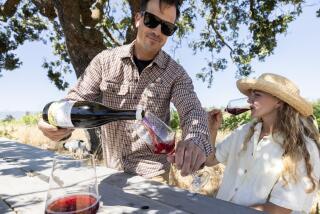Wine Country Shepherd Says Flock Is Heady, Full-Bodied, Just a Bit Nutty : Carneros: Don Watson and his wife, Carolyn, are among a growing number of specialty sheep farmers producing young, high-quality lamb for expensive Napa and Sonoma restaurants. It’s not like accounting.
- Share via
NAPA, Calif. — In his previous life, Don Watson crunched numbers on the 40th floor of a San Francisco high rise, another suit sipping cappuccino in the city’s financial district.
These days, dressed in Levi’s and work boots, Watson trails sheep through the vineyards of Napa and Sonoma counties. He raises fancy lambs to accompany the area’s pinot noir.
“It’s the freedom,” said Watson, 37, as he looked over the green hills of the Carneros, a windblown, grape-growing region on the southern edges of Sonoma and Napa counties.
Watson and his wife, Carolyn, are among a growing number of specialty sheep farmers producing young, high-quality lamb for expensive area restaurants. What separates Watson from the rest of the gourmet flock is that he lets his sheep forage in the vineyards during winter and early spring.
Carneros, which means sheep or ram in Spanish, provided undulating pastureland for more than 100 years before the grape invasion 25 years ago, when investors began buying up ranches and planting vines.
“Don has put the carneros back in Carneros,” said Karen Bower, viticulturist at Buena Vista Carneros, one of the vineyards where Watson’s 400 ewes graze from November until the vines begin sending out green shoots in early spring.
On a clear day, Watson can see the San Francisco skyline he left behind three years ago.
“I’m outdoors all day and I love it. Sure, it’s pouring rain and freezing cold on some days, but where else can you see such beautiful country every day?” he said.
A Calistoga resident, Watson often travels 150 miles a day within the two wine regions to run his sheep business, Napa Valley Lamb Co. Watson’s 2-year-old son, Donny, and 6-year-old daughter, Andrea, often tag along on the sheep trail.
“I get to see more of my children since I left the corporate world,” Watson said. His trademarked lamb is served in top local restaurants such as the Lark Creek Inn in Larkspur, Mustard’s Grill in the Napa Valley and San Francisco’s Fog City Diner.
Like long-ago shepherds, Watson moves his sheep from field to field, utilizing other peoples’ land. His ewes are bred to forage.
“We make no bones about it. We put them on the range and they have to make it. If they can’t get out and find their own food, we don’t want them,” he said.
From November when the vineyards go dormant until late March or early April, Watson’s sheep munch on mustard, clover and fescue in the avenues between the vine rows at the Buena Vista Winery’s Carneros vineyards in Sonoma County.
“These are weeder sheep,” said Watson.
The sight of the white sheep grazing has become a favorite subject for Wine Country photographers, who see it as European. But mixing sheep and vineyards is more than creating a bucolic backdrop.
“It’s really a practical thing to have sheep in the vineyards,” said Bower, adding that the sheep were invaluable during this unusually wet winter because they could get into soggy vineyards when tractors couldn’t.
Bower said it’s important to have the grass between rows mowed before the frost-danger season starts in mid-March. She said the lower the grass, the more the cold air circulates within the vineyard and the lower the chance of frost damage to the tender green buds.
“When the weeds in a vineyard are at waist level, there is more frost threat. Basically, the sheep do the first spring mowing for us,” she said.
Watson, a former accountant for Arthur Andersen & Co., wanted to be a sheep rancher ever since he was a youngster growing up in Stockton.
He wasn’t reared on a sheep ranch but had come to know many of the Basque sheep ranchers in the San Joaquin Valley and respected their simple, hard-working lifestyle.
So while most children were dreaming of careers as astronauts or football players, Watson had visions of herding sheep, sacking wool and wrestling lambs. He took the plunge after a career as an accountant proved as sterile as he imagined.
“You get to the point where there is more to life than money,” said Watson. He quit his accounting job and, with wife Carolyn, spent a year working on sheep ranches in Australia and New Zealand.
He worked on ranches with 10,000 ewes, quickly learning that to make a living with sheep one has to utilize the grass provided by Mother Nature and keep production costs down.
After they returned from Down Under, the Watsons moved to a 400-acre ranch on the southern slopes of Mt. St. Helena that belongs to his wife’s family. The land is rough, rocky and teeming with predators, such as coyotes and mountain lions.
Sheep wouldn’t last long on this ranch so he takes them on the road, using land between Napa and Petaluma for his roving flock.
Watson’s new career offers him blue skies, a chance to be outdoors and time to be with his family, but the money falls far short of an accountant’s paycheck in San Francisco.
Watson markets 500 to 600 lambs a year, with a gross value of $50,000 to $60,000.
A gang of coyotes earlier this year killed 100 lambs, a $10,000 loss. It doesn’t take an accountant to figure that the coyote attack will sharply reduce Watson’s hourly pay at the end of the year.
Still, he’s not ready to get back in his suit and pore over accounting sheets.
“I decided this is the life I want and I will make it work. If not here, then in New Zealand,” he said.
More to Read
Sign up for Essential California
The most important California stories and recommendations in your inbox every morning.
You may occasionally receive promotional content from the Los Angeles Times.










